Did you know, of all the trees across the Boston Common, the Public Garden, and the Commonwealth Avenue Mall, only about a quarter of them are Elms? That number used to be much higher, in the thousands, prior to the introduction of Dutch Elm Disease (DED). The Elm is an important landscape element in the history of these parks, and in the history of American community development. In many ways, these surviving Elm trees speak of our collective failures and successes. Given today's worldwide pandemic, the Elm stands as an example of survival. The Friends' Elm Preservation Program, developed and carried out by Norm Helie, arborist and soil scientist, and Christine Helie, entomologist, of The Growing Tree, aims to expand the story of the Elm through our team's research into the tree's history, its decline, and its preservation with a close study and care of our living collection.
So now, let's meet some of the Elms.
The Elm genus can be found broadly distributed over temperate environments across Asia, Europe, and North America. Elm flowers are not often noticed, for they bloom in early spring and have no true petals. The flowers are perfect, meaning they contain both male and female parts, and rely on the wind as their main mode of pollination. Their fruits, which could be seen floating all across our parks a few weeks ago, are called samaras. Maple trees also have samaras, though they are double samaras. Think of the 'helicopters' you may have played with as a kid. Unlike the Maple though, the samaras of Elms are single and round in shape. The photos below illustrate the flowers (left) and samaras (right).
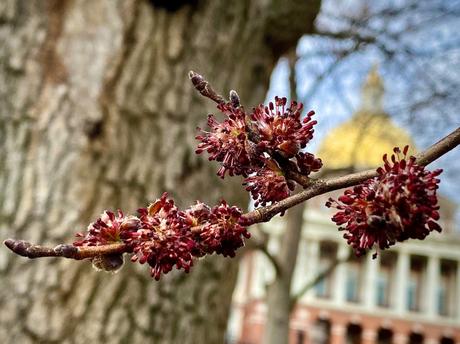
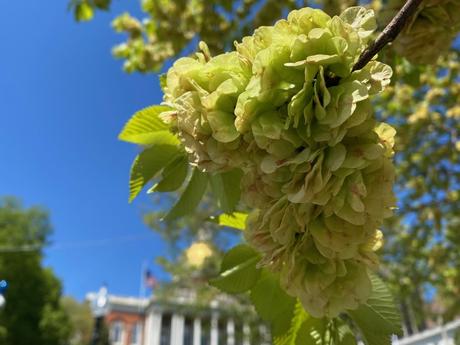
Elms are generally quick growers, but certainly not short lived. Many species can live for hundreds of years and at maturity can have canopies that spread 125-150' and can reach heights of 100-150'. This growth requires safety and pruning protocols to be in place, along with an understanding of the trees' need for proper and continual soil nutrition, essential in the highly managed landscapes of our parks.
The American Elm (Ulmus americana), the Massachusetts State tree and a North American native, had embodied America's built environments through the early 20th Century. It was lauded for its stately vase-shaped habit that graced our parks, malls, paths, and roads. At one point, its popularity made it one of the highest trees in production. Its popularity also led to its demise once DED began moving through the monoculture of plantings. American Elm can be found by the Newbury St. gate of the Garden, in a small triangle of lawn (photo below). Also in the Garden, a pair of large specimens can be found east of the Marvin Goody flagpole along Charles St. The last true, non-hybridized, American Elm on the Common can be found on Railroad Mall, just west of the Visitor Information Center. The tree may never reach the lore of the Great Elm of the Common but nonetheless, it is the last.
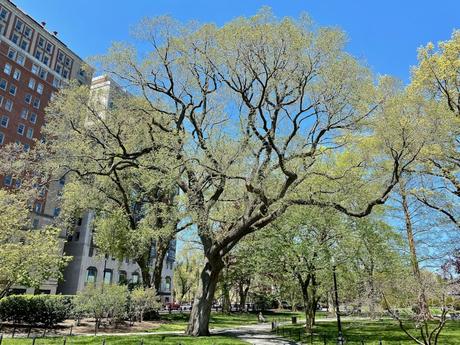
The English Elm (U. procera) represented the first plantings on the Boston Common, formally located along what we now call Lafayette Mall. At the Shaw 54th Memorial, and also on the Common, there are four that have stood for centuries ( BG Article) and may have been planted by John Hancock when he lived across the street. In all, the Friends cares for 60 English Elms across the three parks, most concentrated in the Common (25) and Mall (32). An interesting article about the English Elm's history and its contribution to genetic homogeneity, through DNA investigation, can be found here. The image below shows remaining English Elm street trees lining Commonwealth Ave. just west of Mass Ave., under the meticulous care of our program.
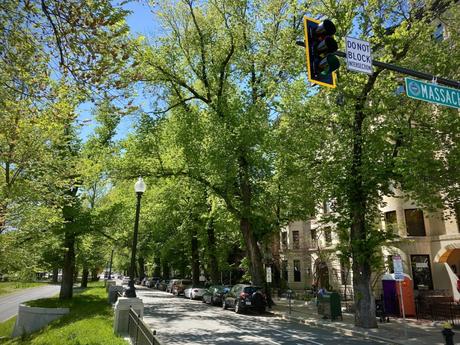
The Slippery Elm (U. rubra), another native, was not as popular of a planting due to its less desirable form when compared to the American Elm. It gets its common name from a 'slippery' substance created by its inner bark. The substance has been used to alleviate sore throats, sometimes brewed as a tea. Its "rubra" species moniker is derived from its buds appearing red during the winter. In Massachusetts, it's actually not very common in the east, but far more common in the western part of the state.
The September Elm (U. serotina), found on the Mall, unlike other Elms, which flower in early spring, pushes blooms during the Autumn. In fact, it's one of two southern native species that behave in this manner, Cedar Elm (U. crassifolia), also on the Mall, being the other. The lumber industry seeks out the September Elm and another species, the Rock Elm (U. thomasii), for their strong and desirable red-brown wood. The lone Rock Elm in the three parks can be found in the Garden near the Tool Shed.
The Belgian Elms (U. x hollandica 'Belgica'), represent some of the older Elms in the Public Garden and can be found along the Boylston St. promenade (photo below). Their planting coincides with the removal of the subway entrance, over a century ago, from inside the Garden.
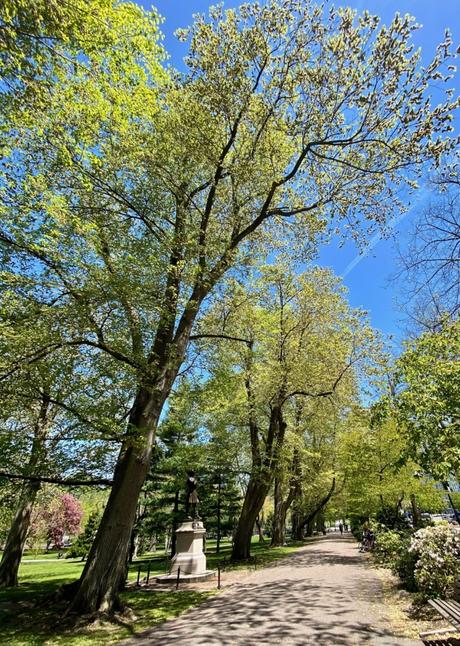
The Huntingdon Elm (U. x hollandica 'Vegeta'), a close relative of the Belgian Elm, is most easily distinguished from the Belgian by its samaras. In the image below, the branch to the left represents the Huntingdon with the red centers to the samaras, and the Belgian to the right.
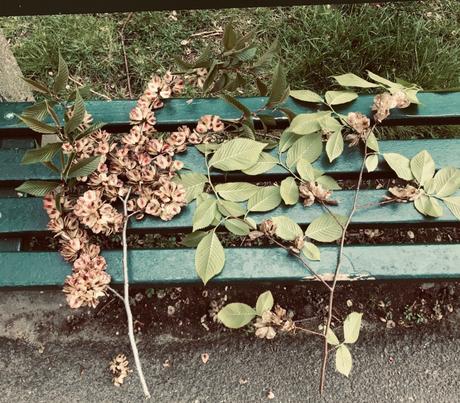
The Buisman Elm (U. minor 'Christine Buisman'), located on the Mall, was one of the first cultivars created, named after Dutch phytopathologist Christine Buisman, during the initial efforts to develop DED resistant varieties. One argued shortcoming of the Buisman Elm was that its habit was unlike that of other Elms, and to some, not as visually pleasing. The Buisman shown below is located on the Berkeley-Clarendon block, the sixth tree from Berkeley St, on the inbound side.

The Lacebark Elm, (U. parviflora), planted in 1989, has stunning textured bark (photo below) found on the eastern side of the Public Garden lagoon, near the flagpole. Known to be resistant to DED, we've recently had to remove a specimen due to a mass beetle attack that led to a confirmed DED diagnosis.
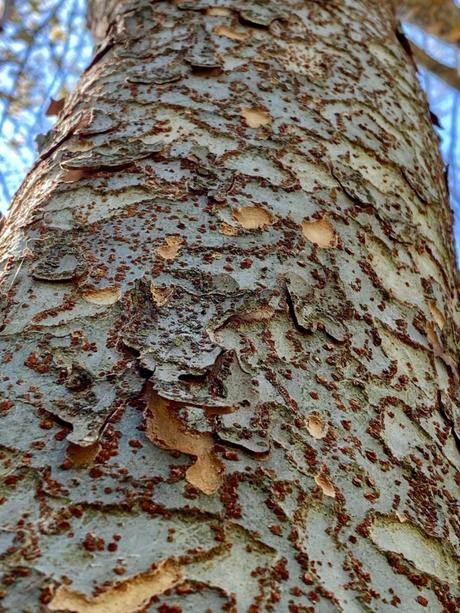
In addition to the older cultivars, newer created varieties, attempting to increase DED resistance, can be found throughout the three parks. These include the Princeton, the Liberty, and the Homestead Elms, the latter of which can be found on the Common lining Liberty Mall (photo below). The Homestead Elms are examples of complex combinations of various Elm species, including the Siberian, multiple Dutch Elm varieties, and American Elm. As we discuss next, DED is a complex issue and the planting of hybrids alone is not a solution to the problem. Other variables need to be considered.
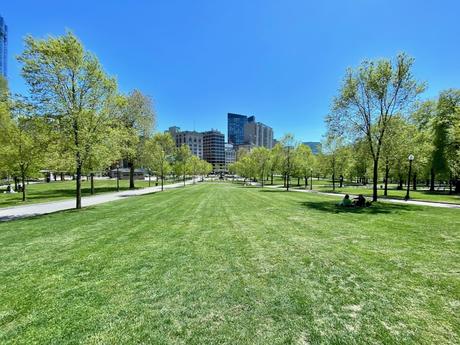
The characteristics that made the Elm a popular selection for developed streetscapes and greenspaces also led to its demise, as mentioned earlier, with the introduction of DED. The roots of the name 'Dutch' are from its discovery taking place in the Netherlands, ca. 1918. The disease was introduced into North America in Cleveland, OH ca. 1930, although there were reports of Elm die-off well before this date. The fungus that causes the disease is spread from tree to tree through three different methods of transmission. It has been known for more than fifty years that the disease is primarily transmitted via twig feeding and root graft infection. This older research asserts that the bark beetle leaves a dead, diseased, or dying Elm and moves many miles to a healthy elm carrying the disease to do twig feeding. Our field research shows that bark beetle breeding is the primary cause of DED infection. A secondary infection occurs through twig feeding and finally, root graft infection is tertiary.
European Elm Bark Beetles (EEBB) breed in live Elms, not just dead, dying, or diseased Elms. Throughout the growing season, twig feeding damage by bark beetles occurs less frequently, whereas bark beetle breeding damage always occurs. This activity takes place under the bark, within the vascular tissue of the tree, causing serious strain and can lead to death, even without the influence of DED. The tree's natural response is to create a sticky gummy substance to prevent spreading the disease, but this also inhibits the transportation of water throughout the tree, leading to a quick decline and eventual death.
Knowing the beetle uses live trees, not just dead or dying trees, we must concentrate on getting and keeping these trees as healthy as possible. A tree's health dictates how well it can defend itself against beetle breeding. Focusing on nutrition, and reducing stress will help these trees become stronger, making it more difficult for the EEBB to exploit the tree.
The traditional response to a declining Elm had been the rapid sanitation, or removal of the tree, though the Friends have transitioned to the dormant (a seasonal state of inactivity and energy conservation in plants) removal of infested trees. By creating a trap tree (a tree purposely girdled in order to lure pests) our approach reduces the dispersal of beetles from the felled tree, to otherwise unaffected specimens. Essentially the thought is, don't strike the hornet's nest! This sanitation strategy, combined with weekly pruning efforts, April-October, to visually inspect branches and send out samples to a lab for DED analysis while also removing weak or dead material, rounds out an effort that reduces both disease and vector (bark beetle) from the site.
We've been able to recognize this trend of beetles moving from a removed tree, to other trees, through our constant bark beetle population density monitoring. You may have seen these green boxes scattered across the parks, which are pheromone traps designed to attract the EEBB. For the last eight years the beetles have been monitored and carefully counted on each trap, twice a month, during the growing season. These beetle counts illustrate much about their activities, movement, and behaviors.
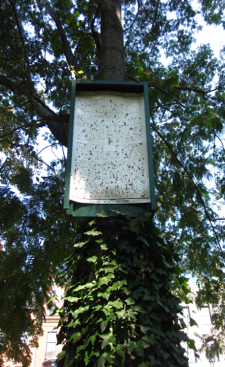
For 50 years, despite the challenges and sadness of tree loss, due to EEBB and DED, the Friends of the Public Garden has remained vigilant in the care and upkeep of all Elms in the Common, Garden and Mall. Our strategy of care has evolved and our continued research, with the intent to publish, on the beetle's behavior and the nourishment needs of the trees, influences how we take care of our Elm collection.
So, next time you're in our parks, pause at an Elm and realize these beautiful trees are survivors of their own pandemic, representing the strength and ability to overcome via applied science and the Friends' concerted effort to learn and adapt. Hopefully with this mindset, the Elms you look at today will endure and be enjoyed by generations to come!
